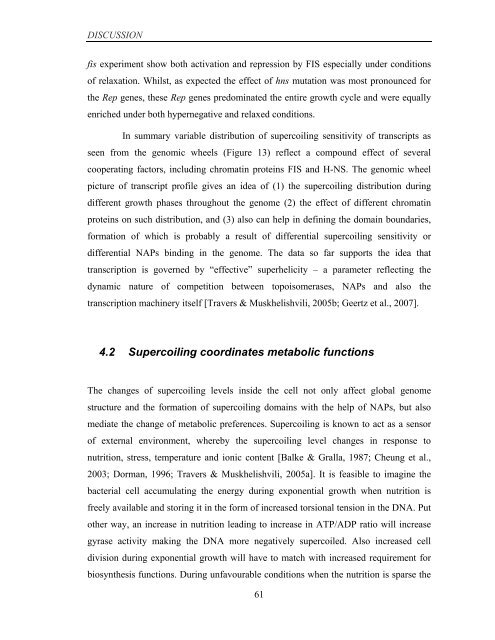Coordinated regulation of gene expression by E ... - Jacobs University
Coordinated regulation of gene expression by E ... - Jacobs University
Coordinated regulation of gene expression by E ... - Jacobs University
You also want an ePaper? Increase the reach of your titles
YUMPU automatically turns print PDFs into web optimized ePapers that Google loves.
DISCUSSION<br />
fis experiment show both activation and repression <strong>by</strong> FIS especially under conditions<br />
<strong>of</strong> relaxation. Whilst, as expected the effect <strong>of</strong> hns mutation was most pronounced for<br />
the Rep <strong>gene</strong>s, these Rep <strong>gene</strong>s predominated the entire growth cycle and were equally<br />
enriched under both hypernegative and relaxed conditions.<br />
In summary variable distribution <strong>of</strong> supercoiling sensitivity <strong>of</strong> transcripts as<br />
seen from the genomic wheels (Figure 13) reflect a compound effect <strong>of</strong> several<br />
cooperating factors, including chromatin proteins FIS and H-NS. The genomic wheel<br />
picture <strong>of</strong> transcript pr<strong>of</strong>ile gives an idea <strong>of</strong> (1) the supercoiling distribution during<br />
different growth phases throughout the genome (2) the effect <strong>of</strong> different chromatin<br />
proteins on such distribution, and (3) also can help in defining the domain boundaries,<br />
formation <strong>of</strong> which is probably a result <strong>of</strong> differential supercoiling sensitivity or<br />
differential NAPs binding in the genome. The data so far supports the idea that<br />
transcription is governed <strong>by</strong> “effective” superhelicity – a parameter reflecting the<br />
dynamic nature <strong>of</strong> competition between topoisomerases, NAPs and also the<br />
transcription machinery itself [Travers & Muskhelishvili, 2005b; Geertz et al., 2007].<br />
4.2 Supercoiling coordinates metabolic functions<br />
The changes <strong>of</strong> supercoiling levels inside the cell not only affect global genome<br />
structure and the formation <strong>of</strong> supercoiling domains with the help <strong>of</strong> NAPs, but also<br />
mediate the change <strong>of</strong> metabolic preferences. Supercoiling is known to act as a sensor<br />
<strong>of</strong> external environment, where<strong>by</strong> the supercoiling level changes in response to<br />
nutrition, stress, temperature and ionic content [Balke & Gralla, 1987; Cheung et al.,<br />
2003; Dorman, 1996; Travers & Muskhelishvili, 2005a]. It is feasible to imagine the<br />
bacterial cell accumulating the energy during exponential growth when nutrition is<br />
freely available and storing it in the form <strong>of</strong> increased torsional tension in the DNA. Put<br />
other way, an increase in nutrition leading to increase in ATP/ADP ratio will increase<br />
gyrase activity making the DNA more negatively supercoiled. Also increased cell<br />
division during exponential growth will have to match with increased requirement for<br />
biosynthesis functions. During unfavourable conditions when the nutrition is sparse the<br />
61
















